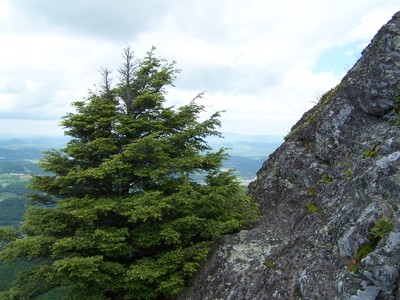Carolina hemlock (Tsuga caroliniana) is a rare Southern Appalachian tree
species that is being devastated by an exotic insect. Researchers discovered
that Carolina hemlock populations are highly genetically differentiated from
each other and highly inbred. The results underscore the urgency of conserving
the species’ genetic variation.
 USDA Forest Service scientists and their partners are working to save
native hemlock tree species from the hemlock woolly adelgid (HWA), an invasive
insect from Japan. Carolina hemlock (Tsuga
caroliniana) is particularly at risk because it occurs only in tiny
isolated populations in the Southern Appalachians. A North Carolina State
University scientist who cooperates with the Eastern Forest Environmental
Threat Assessment Center led the first comprehensive molecular marker study of Carolina
hemlock’s genetic diversity across the range of the species. Because the
species is pollinated by wind, researchers expected to find small genetic
differences among Carolina hemlock populations. Instead, they discovered that
Carolina hemlock populations are highly differentiated from each other and highly
inbred. Also, several populations have unique genetic variation not found
elsewhere. These results, published in the journal Tree Genetics & Genomes, suggest that the species is not able to
effectively disperse its seeds or pollen over long distances, increasing the
isolation and vulnerability of individual populations. Scientists and land
managers can apply the study results to target conservation efforts, to
prioritize the populations where seed collection is most needed, and to inform
HWA-resistant tree breeding programs.
USDA Forest Service scientists and their partners are working to save
native hemlock tree species from the hemlock woolly adelgid (HWA), an invasive
insect from Japan. Carolina hemlock (Tsuga
caroliniana) is particularly at risk because it occurs only in tiny
isolated populations in the Southern Appalachians. A North Carolina State
University scientist who cooperates with the Eastern Forest Environmental
Threat Assessment Center led the first comprehensive molecular marker study of Carolina
hemlock’s genetic diversity across the range of the species. Because the
species is pollinated by wind, researchers expected to find small genetic
differences among Carolina hemlock populations. Instead, they discovered that
Carolina hemlock populations are highly differentiated from each other and highly
inbred. Also, several populations have unique genetic variation not found
elsewhere. These results, published in the journal Tree Genetics & Genomes, suggest that the species is not able to
effectively disperse its seeds or pollen over long distances, increasing the
isolation and vulnerability of individual populations. Scientists and land
managers can apply the study results to target conservation efforts, to
prioritize the populations where seed collection is most needed, and to inform
HWA-resistant tree breeding programs.
Pictured: Researchers found that Carolina hemlock
populations, like this one at Mount Jefferson State Park in North Carolina, are
genetically isolated. Photo by Robert Jetton, North Carolina State University.
Related publications:
Forest Service Partners/Collaborators: Southern Institute of Forest Genetics
External Partners/Collaborators: North Carolina State University
Contact: Kevin Potter, North Carolina State University Cooperating Scientist, kevin.potter@usda.gov
Return to contents
Next -->




